Cabletron Systems 6000 User Manual
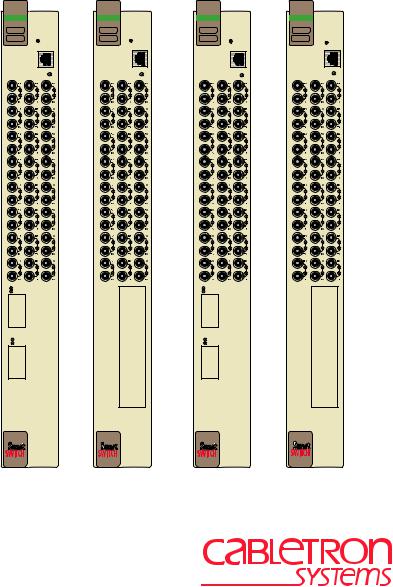
6E128-26, 6E138-25, 6E129-26 and 6E139-25 SmartSwitch 6000 Interface Modules User’s Guide
Ethernet |
Ethernet |
Ethernet |
Ethernet |
6E128-26 |
6E138-25 |
6E129-26 |
6E139-25 |
|
COM |
|
|
COM |
|
|
COM |
|
|
COM |
|
|
|
CPU |
|
CPU |
|
|
|
CPU |
|
CPU |
|
1 |
9 |
17 |
1 |
9 |
17 |
1 |
9 |
17 |
1 |
9 |
17 |
2 |
10 |
18 |
2 |
10 |
18 |
2 |
10 |
18 |
2 |
10 |
18 |
3 |
11 |
19 |
3 |
11 |
19 |
3 |
11 |
19 |
3 |
11 |
19 |
4 |
12 |
20 |
4 |
12 |
20 |
4 |
12 |
20 |
4 |
12 |
20 |
5 |
13 |
21 |
5 |
13 |
21 |
5 |
13 |
21 |
5 |
13 |
21 |
6 |
14 |
22 |
6 |
14 |
22 |
6 |
14 |
22 |
6 |
14 |
22 |
7 |
15 |
23 |
7 |
15 |
23 |
7 |
15 |
23 |
7 |
15 |
23 |
8 |
16 |
24 |
8 |
16 |
24 |
8 |
16 |
24 |
8 |
16 |
24 |
25 |
|
|
|
|
|
25 |
|
|
|
|
|
26 |
|
|
|
|
|
26 |
|
|
|
|
|
6E128-26 |
6E138-25 |
6E129-26 |
6E139-25 |
9032311-03
9032311-03

NOTICE
Cabletron Systems reserves the right to make changes in specifications and other information contained in this document without prior notice. The reader should in all cases consult Cabletron Systems to determine whether any such changes have been made.
The hardware, firmware, or software described in this manual is subject to change without notice.
IN NO EVENT SHALL CABLETRON SYSTEMS BE LIABLE FOR ANY INCIDENTAL, INDIRECT, SPECIAL, OR CONSEQUENTIAL DAMAGES WHATSOEVER (INCLUDING BUT NOT LIMITED TO LOST PROFITS) ARISING OUT OF OR RELATED TO THIS MANUAL OR THE INFORMATION CONTAINED IN IT, EVEN IF CABLETRON SYSTEMS HAS BEEN ADVISED OF, KNOWN, OR SHOULD HAVE KNOWN, THE POSSIBILITY OF SUCH DAMAGES.
1998 by Cabletron Systems, Inc., P.O. Box 5005, Rochester, NH 03866-5005 All Rights Reserved
Printed in the United States of America
Order Number: 9032311-03 August 1998
Cabletron Systems is a registered trademark and SmartSwitch is a trademark of Cabletron Systems, Inc.
All other product names mentioned in this manual may be trademarks or registered trademarks of their respective companies.
FCC NOTICE
This device complies with Part 15 of the FCC rules. Operation is subject to the following two conditions: (1) this device may not cause harmful interference, and (2) this device must accept any interference received, including interference that may cause undesired operation.
NOTE: This equipment has been tested and found to comply with the limits for a Class A digital device, pursuant to Part 15 of the FCC rules. These limits are designed to provide reasonable protection against harmful interference when the equipment is operated in a commercial environment. This equipment uses, generates, and can radiate radio frequency energy and if not installed in accordance with the operator’s manual, may cause harmful interference to radio communications. Operation of this equipment in a residential area is likely to cause interference in which case the user will be required to correct the interference at his own expense.
WARNING: Changes or modifications made to this device which are not expressly approved by the party responsible for compliance could void the user’s authority to operate the equipment.
Printed on |
Recycled Paper |
6E128-26, 6E138-25, 6E129-26 and 6E139-25 User’s Guide |
i |
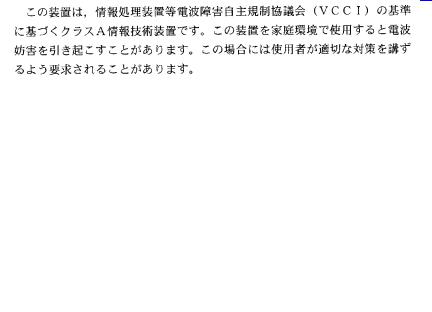
Notice
INDUSTRY CANADA NOTICE
This digital apparatus does not exceed the Class A limits for radio noise emissions from digital apparatus set out in the Radio Interference Regulations of the Canadian Department of Communications.
Le présent appareil numérique n’émet pas de bruits radioélectriques dépassant les limites applicables aux appareils numériques de la class A prescrites dans le Règlement sur le brouillage radioélectrique édicté par le ministère des Communications du Canada.
VCCI NOTICE
This is a Class A product based on the standard of the Voluntary Control Council for Interference by Information Technology Equipment (VCCI). If this equipment is used in a domestic environment, radio disturbance may arise. When such trouble occurs, the user may be required to take corrective actions.
CABLETRON SYSTEMS, INC. PROGRAM LICENSE AGREEMENT
IMPORTANT: Before utilizing this product, carefully read this License Agreement.
This document is an agreement between you, the end user, and Cabletron Systems, Inc. (“Cabletron”) that sets forth your rights and obligations with respect to the Cabletron software program (the “Program”) contained in this package. The Program may be contained in firmware, chips or other media. BY UTILIZING THE ENCLOSED PRODUCT, YOU ARE AGREEING TO BECOME BOUND BY THE TERMS OF THIS AGREEMENT, WHICH INCLUDES THE LICENSE AND THE LIMITATION OF WARRANTY AND DISCLAIMER OF LIABILITY. IF YOU DO NOT AGREE TO THE TERMS OF THIS AGREEMENT, PROMPTLY RETURN THE UNUSED PRODUCT TO THE PLACE OF PURCHASE FOR A FULL REFUND.
ii |
6E128-26, 6E138-25, 6E129-26 and 6E139-25 User’s Guide |

Notice
CABLETRON SOFTWARE PROGRAM LICENSE
1.LICENSE. You have the right to use only the one (1) copy of the Program provided in this package subject to the terms and conditions of this License Agreement.
You may not copy, reproduce or transmit any part of the Program except as permitted by the Copyright Act of the United States or as authorized in writing by Cabletron.
2.OTHER RESTRICTIONS. You may not reverse engineer, decompile, or disassemble the Program.
3.APPLICABLE LAW. This License Agreement shall be interpreted and governed under the laws and in the state and federal courts of New Hampshire. You accept the personal jurisdiction and venue of the New Hampshire courts.
EXCLUSION OF WARRANTY AND DISCLAIMER OF LIABILITY
1.EXCLUSION OF WARRANTY. Except as may be specifically provided by Cabletron in writing, Cabletron makes no warranty, expressed or implied, concerning the Program (including its documentation and media).
CABLETRON DISCLAIMS ALL WARRANTIES, OTHER THAN THOSE SUPPLIED TO YOU BY CABLETRON IN WRITING, EITHER EXPRESSED OR IMPLIED, INCLUDING BUT NOT LIMITED TO IMPLIED WARRANTIES OF MERCHANTABILITY AND FITNESS FOR A PARTICULAR PURPOSE, WITH RESPECT TO THE PROGRAM, THE ACCOMPANYING WRITTEN MATERIALS, AND ANY ACCOMPANYING HARDWARE.
2.NO LIABILITY FOR CONSEQUENTIAL DAMAGES. IN NO EVENT SHALL CABLETRON OR ITS SUPPLIERS BE LIABLE FOR ANY DAMAGES WHATSOEVER (INCLUDING, WITHOUT LIMITATION, DAMAGES FOR LOSS OF BUSINESS, PROFITS, BUSINESS INTERRUPTION, LOSS OF BUSINESS INFORMATION, SPECIAL, INCIDENTAL, CONSEQUENTIAL, OR RELIANCE DAMAGES, OR OTHER LOSS) ARISING OUT OF THE USE OR INABILITY TO USE THIS CABLETRON PRODUCT, EVEN IF CABLETRON HAS BEEN ADVISED OF THE POSSIBILITY OF SUCH DAMAGES. BECAUSE SOME STATES DO NOT ALLOW THE EXCLUSION OR LIMITATION OF LIABILITY FOR CONSEQUENTIAL OR INCIDENTAL DAMAGES, OR ON THE DURATION OR LIMITATION OF IMPLIED WARRANTIES, IN SOME INSTANCES THE ABOVE LIMITATIONS AND EXCLUSIONS MAY NOT APPLY TO YOU.
UNITED STATES GOVERNMENT RESTRICTED RIGHTS
The enclosed product (a) was developed solely at private expense; (b) contains “restricted computer software” submitted with restricted rights in accordance with Section 52227-19 (a) through (d) of the Commercial Computer Software - Restricted Rights Clause and its successors, and (c) in all respects is proprietary data belonging to Cabletron and/or its suppliers.
For Department of Defense units, the product is licensed with “Restricted Rights” as defined in the DoD Supplement to the Federal Acquisition Regulations, Section 52.227-7013 (c) (1) (ii) and its successors, and use, duplication, disclosure by the Government is subject to restrictions as set forth in subparagraph (c) (1) (ii) of the Rights in Technical Data and Computer Software clause at 252.227-7013. Cabletron Systems, Inc., 35 Industrial Way, Rochester, New Hampshire 03867-0505.
6E128-26, 6E138-25, 6E129-26 and 6E139-25 User’s Guide |
iii |

Notice
DECLARATION OF CONFORMITY
Application of Council Directive(s): 89/336/EEC
73/23/EEC
Manufacturer’s Name: Cabletron Systems, Inc.
Manufacturer’s Address: 35 Industrial Way
PO Box 5005
Rochester, NH 03867
European Representative Name: Mr. J. Solari
European Representative Address: Cabletron Systems Limited
Nexus House, Newbury Business Park
London Road, Newbury
Berkshire RG13 2PZ, England
Conformance to Directive(s)/Product Standards: EC Directive 89/336/EEC
EC Directive 73/23/EEC EN 55022
EN 50082-1 EN 60950
Equipment Type/Environment: Networking Equipment, for use in a
Commercial or Light Industrial Environment.
We the undersigned, hereby declare, under our sole responsibility, that the equipment packaged with this notice conforms to the above directives.
Manufacturer |
Legal Representative in Europe |
Mr. Ronald Fotino |
Mr. J. Solari |
___________________________________ |
___________________________________ |
Full Name |
Full Name |
Principal Compliance Engineer |
Managing Director - E.M.E.A. |
___________________________________ |
___________________________________ |
Title |
Title |
Rochester, NH, USA |
Newbury, Berkshire, England |
___________________________________ |
___________________________________ |
Location |
Location |
iv |
6E128-26, 6E138-25, 6E129-26 and 6E139-25 User’s Guide |
CONTENTS
CHAPTER 1 |
INTRODUCTION |
|
|
1.1 |
Using This Guide ......................................................................... |
1-1 |
|
1.2 |
Structure of This Guide................................................................ |
1-1 |
|
1.3 |
6E12X-26 and 6E13X-25 Overview............................................. |
1-2 |
|
|
1.3.1 |
Connectivity .................................................................... |
1-4 |
|
1.3.2 Full Duplex Switched Ethernet........................................ |
1-4 |
|
|
1.3.3 |
Management................................................................... |
1-4 |
|
1.3.4 |
Switching Options ........................................................... |
1-5 |
|
1.3.5 |
Standards Compatibility.................................................. |
1-5 |
|
1.3.6 |
LANVIEW Diagnostic LEDs ............................................ |
1-5 |
|
1.3.7 |
Year 2000 Compliant ...................................................... |
1-5 |
|
1.3.8 Runtime IP Address Discovery ....................................... |
1-6 |
|
1.4 |
Local Management Features....................................................... |
1-6 |
|
|
1.4.1 |
Distributed Chassis Management ................................... |
1-6 |
|
1.4.2 |
Remote Monitoring (RMON) ........................................... |
1-7 |
|
1.4.3 |
Broadcast Suppression................................................... |
1-7 |
|
1.4.4 |
Port Redirect Function .................................................... |
1-7 |
|
1.4.5 |
SmartTrunk ..................................................................... |
1-8 |
|
1.4.6 Additional Local Management Functions........................ |
1-8 |
|
1.5 |
Optional Features ........................................................................ |
1-9 |
|
1.6 |
Document Conventions ............................................................. |
1-10 |
|
1.7 |
Getting Help............................................................................... |
1-10 |
|
1.8 |
Related Manuals........................................................................ |
1-12 |
|
CHAPTER 2 |
NETWORK REQUIREMENTS |
|
|
2.1 |
SmartTrunk |
.................................................................................. |
2-1 |
2.2 |
10BASE-F Network ..................................................................... |
2-2 |
|
2.3 |
FOIRL Network............................................................................ |
2-2 |
|
2.4 |
100BASE-TX .................................................................Network |
2-2 |
|
2.5 |
100BASE-FX ..............................................Fiber Optic Network |
2-2 |
|
CHAPTER 3 |
INSTALLATION |
|
|
3.1 |
Required Tools ............................................................................ |
3-1 |
|
3.2 |
Unpacking the 6E12X-26 and 6E13X-25..................................... |
3-1 |
|
3.3 |
6E12X-26 and 6E13X-25 Options ............................................... |
3-2 |
|
3.4 |
Power Supply Requirements ....................................................... |
3-2 |
|
3.5Installing the 6E12X-26 and 6E13X-25 Into the 6C105 Chassis . 3-3
6E128-26, 6E138-25, 6E129-26 and 6E139-25 User’s Guide |
v |

Contents
3.6 Connecting to the Network........................................................... |
3-5 |
3.6.1Connecting Fiber Optic Cables to Ports 1
|
|
Through 24 of the Modules ............................................. |
3-6 |
|
3.6.2 Connecting a UTP Segment to the FE-100TX ................ |
3-8 |
|
|
3.6.3 Connecting a Fiber Optic Segment to the |
|
|
|
|
FE-100FX and FE-100F3 ................................................ |
3-9 |
3.7 |
Completing the Installation......................................................... |
3-11 |
|
CHAPTER 4 |
TROUBLESHOOTING |
|
|
4.1 |
Using LANVIEW........................................................................... |
4-1 |
|
4.2 |
FE-100TX LED............................................................................. |
4-4 |
|
4.3 |
Troubleshooting Checklist............................................................ |
4-6 |
|
4.4 |
Using the RESET Button ............................................................. |
4-7 |
|
CHAPTER 5 |
LOCAL MANAGEMENT |
|
|
5.1 |
Overview ...................................................................................... |
5-1 |
|
5.2 |
Local Management Keyboard Conventions ................................. |
5-2 |
|
5.3 |
Management Terminal Setup....................................................... |
5-3 |
|
|
5.3.1 |
Console Cable Connection.............................................. |
5-3 |
|
5.3.2 Connecting an Uninterruptible Power Supply.................. |
5-4 |
|
|
5.3.3 Management Terminal Setup Parameters ...................... |
5-5 |
|
|
5.3.4 |
Telnet Connections ......................................................... |
5-6 |
5.4 |
Accessing Local Management ..................................................... |
5-7 |
|
|
5.4.1 Navigating Local Management Screens.......................... |
5-8 |
|
|
5.4.2 Selecting Local Management Menu Screen Items........ |
5-10 |
|
|
5.4.3 Exiting Local Management Screens.............................. |
5-10 |
|
5.5 |
The Main Menu Screen.............................................................. |
5-12 |
|
5.6 |
Chassis Menu Screen................................................................ |
5-14 |
|
5.7 |
Chassis Configuration Screen ................................................... |
5-16 |
|
|
5.7.1 Setting the IP Address................................................... |
5-18 |
|
|
5.7.2 Setting the Subnet Mask ............................................... |
5-19 |
|
|
5.7.3 Setting the Chassis Date............................................... |
5-20 |
|
|
5.7.4 Setting the Chassis Time .............................................. |
5-20 |
|
|
5.7.5 Entering a New Screen Refresh Time........................... |
5-21 |
|
|
5.7.6 Setting the Screen Lockout Time .................................. |
5-21 |
|
|
5.7.7 Setting the Operational Mode........................................ |
5-22 |
|
5.8 |
SNMP Community Names Screen............................................. |
5-24 |
|
|
5.8.1 |
Establishing Community Names ................................... |
5-25 |
vi |
6E128-26, 6E138-25, 6E129-26 and 6E139-25 User’s Guide |
|
|
Contents |
|
5.9 |
SNMP Traps Screen.................................................................. |
5-27 |
|
|
5.9.1 |
Configuring the Trap Table ........................................... |
5-28 |
5.10 |
Chassis Environmental Screen ................................................. |
5-29 |
|
5.11 |
Port Redirect Function Screen .................................................. |
5-30 |
|
|
5.11.1 |
Displaying the Source and Destination Entries............. |
5-32 |
|
5.11.2 |
Changing Source and Destination Ports....................... |
5-33 |
5.12 |
Module Selection Screen........................................................... |
5-34 |
|
|
5.12.1 |
Selecting a Module ....................................................... |
5-35 |
5.13 |
Module Menu Screen ................................................................ |
5-36 |
|
5.14 |
Module Configuration Menu Screen .......................................... |
5-38 |
|
5.15 |
General Configuration Screen ................................................... |
5-41 |
|
|
5.15.1 |
Setting the IP Address .................................................. |
5-45 |
|
5.15.2 |
Setting the Subnet Mask............................................... |
5-46 |
|
5.15.3 |
Setting the Default Gateway ......................................... |
5-47 |
|
5.15.4 |
Setting the TFTP Gateway IP Address......................... |
5-48 |
|
5.15.5 |
Setting the Module Date ............................................... |
5-48 |
|
5.15.6 |
Setting the Module Time............................................... |
5-49 |
|
5.15.7 |
Entering a New Screen Refresh Time .......................... |
5-50 |
|
5.15.8 |
Setting the Screen Lockout Time.................................. |
5-50 |
|
5.15.9 |
Setting the Operational Mode ....................................... |
5-51 |
|
5.15.10 Setting the Management Mode..................................... |
5-52 |
|
|
5.15.11 Configuring the COM Port ............................................ |
5-53 |
|
|
5.15.12 Changing the Com Port Application.............................. |
5-55 |
|
|
5.15.13 Clearing NVRAM .......................................................... |
5-56 |
|
|
5.15.14 Enabling/Disabling IP Fragmentation ........................... |
5-57 |
|
5.16 |
SNMP Community Names Screen ............................................ |
5-57 |
|
|
5.16.1 |
Establishing Community Names ................................... |
5-59 |
5.17 |
SNMP Traps Screen.................................................................. |
5-60 |
|
|
5.17.1 |
Configuring the Trap Table ........................................... |
5-61 |
5.18 |
Switch Configuration Screen ..................................................... |
5-62 |
|
|
5.18.1 |
Setting the STA............................................................. |
5-65 |
|
5.18.2 |
Setting the Age Time .................................................... |
5-65 |
|
5.18.3 |
Setting (Enabling or Disabling) the Port Status ............ |
5-65 |
5.19 |
Ethernet Full Duplex Configuration Screen ............................... |
5-66 |
|
|
5.19.1 |
Setting the Operation Mode.......................................... |
5-68 |
5.20 |
Module Specific Configuration Menu Screen ............................ |
5-69 |
|
5.21 |
System Resources Screen ........................................................ |
5-71 |
|
|
5.21.1 |
Setting the Reset Peak Utilization ................................ |
5-73 |
5.22 |
High Speed Interface Configuration Screen (6E12X-26 Only) .. |
5-74 |
|
|
5.22.1 |
Configuring an FE-100FX or FE-100F3........................ |
5-77 |
|
5.22.2 |
Setting the FE-100FX and FE-100F3 |
|
|
|
Operational Mode ......................................................... |
5-77 |
|
5.22.3 |
Configuring an FE-100TX ............................................. |
5-78 |
6E128-26, 6E138-25, 6E129-26 and 6E139-25 User’s Guide |
vii |

Contents
|
5.22.4 Setting the FE-100TX Operational Mode ...................... |
5-78 |
|
|
5.22.5 Setting the FE-100TX Advertised Ability ....................... |
5-78 |
|
5.23 |
Flash Download Screen............................................................. |
5-79 |
|
|
5.23.1 Image File Download Using TFTP ................................ |
5-82 |
|
|
5.23.2 Image File Download Using RUNTIME ......................... |
5-83 |
|
|
5.23.3 Image File Download Using BootP................................ |
5-84 |
|
5.24 |
Port Redirect Function Screen................................................... |
5-85 |
|
|
5.24.1 Displaying the Source and Destination Entries ............. |
5-87 |
|
|
5.24.2 Changing Source and Destination Ports ....................... |
5-87 |
|
5.25 |
Broadcast Suppression Screen ................................................. |
5-89 |
|
|
5.25.1 |
Setting the Threshold .................................................... |
5-90 |
|
5.25.2 Setting the Reset Peak Switch ...................................... |
5-91 |
|
5.26 |
Module Statistics Menu Screen ................................................. |
5-91 |
|
5.27 |
Switch Statistics Screen............................................................. |
5-93 |
|
|
5.27.1 Using the Clear Counters Command ............................ |
5-94 |
|
5.28 |
The Interface Statistics Screen .................................................. |
5-95 |
|
|
5.28.1 |
Displaying Interface Statistics ....................................... |
5-98 |
|
5.28.2 Using the Clear Counters Command ............................ |
5-98 |
|
5.29 |
RMON Statistics Screen ............................................................ |
5-99 |
|
|
5.29.1 |
Displaying RMON Statistics ........................................ |
5-103 |
|
5.29.2 Using the Clear Counters Command .......................... |
5-103 |
|
5.30 |
Network Tools .......................................................................... |
5-104 |
|
|
5.30.1 |
Built-in Commands ...................................................... |
5-105 |
|
5.30.2 |
Special Commands ..................................................... |
5-114 |
APPENDIX A |
SPECIFICATIONS |
|
|
A.1 |
Device Specifications.................................................................. |
A-1 |
|
A.2 |
Physical Properties ..................................................................... |
A-1 |
|
A.3 |
Environmental Requirements...................................................... |
A-1 |
|
A.4 |
Input/Output Ports....................................................................... |
A-2 |
|
A.5 |
COM Port Pinout Assignments ................................................... |
A-3 |
|
A.6 |
Regulatory Compliance............................................................... |
A-3 |
|
APPENDIX B |
FE-100TX, FE-100FX AND FE-100F3 |
|
|
|
|
SPECIFICATIONS |
|
B.1 |
FE-100TX.................................................................................... |
B-1 |
|
B.2 |
FE-100FX.................................................................................... |
B-2 |
|
B.3 |
FE-100F3 .................................................................................... |
B-3 |
|
viii |
6E128-26, 6E138-25, 6E129-26 and 6E139-25 User’s Guide |

Contents
APPENDIX C MODE SWITCH BANK SETTINGS AND OPTIONAL INSTALLATIONS
C.1 |
Required Tools ............................................................................ |
C-1 |
C.2 |
Setting the Mode Switch.............................................................. |
C-1 |
C.3 |
Installing Optional Fast Ethernet Interface Modules.................... |
C-4 |
INDEX
6E128-26, 6E138-25, 6E129-26 and 6E139-25 User’s Guide |
ix |

Contents
x |
6E128-26, 6E138-25, 6E129-26 and 6E139-25 User’s Guide |

CHAPTER 1
INTRODUCTION
Welcome to the Cabletron Systems 6E128-26, 6E138-25, 6E129-26 and 6E139-25 SmartSwitch 6000 Interface Modules User’s Guide. This guide describes the 6E128-26, 6E138-25, 6E129-26 and 6E139-25 Interface Modules and provides information concerning network requirements, installation, troubleshooting, and the use of Local Management.
1.1USING THIS GUIDE
Read through this guide completely to understand the interface module features, capabilities, and Local Management functions. A general working knowledge of Ethernet and IEEE 802.3 type data communications networks and their physical layer components is helpful when using these devices.
NOTE |
Unless noted differently, the information in this guide applies to |
all four SmartSwitch 6000 interface modules, which are |
|
|
referred to as either the “6E12X-26 and 6E13X-25” or the |
|
“module(s)”. |
1.2STRUCTURE OF THIS GUIDE
This guide is organized as follows:
Chapter 1, Introduction, outlines the contents of this manual, describes the features of the 6E12X-26 and 6E13X-25, provides instructions on obtaining additional help and concludes with a list of related manuals.
Chapter 2, Network Requirements, explains the network requirements to consider before installing the 6E12X-26 and 6E13X-25 into the 6C105 SmartSwitch 6000 chassis.
Chapter 3, Installation, provides instructions on how to install the modules in the chassis and connect segments to the devices.
Chapter 4, Troubleshooting, details the 6E12X-26 and 6E13X-25 LANVIEW LEDs that enable you to quickly diagnose network/operational problems.
6E128-26, 6E138-25, 6E129-26 and 6E139-25 User’s Guide |
1-1 |

Chapter 1: Introduction
Chapter 5, Local Management, describes how to access Local Management and use the Local Management screens to manage the 6E12X-26 and 6E13X-25 interface modules and the 6C105 chassis.
Appendix A, Specifications, contains information on functionality and operating specifications, connector pinouts, environmental requirements, and physical properties.
Appendix B, FE-100TX, FE-100FX and FE-100F3 Specifications, contains information about FE-100TX pinouts and information concerning cable types used with the FE-100FX and FE100-F3.
Appendix C, Mode Switch Bank Settings and Optional Installations, describes how to install optional Fast Ethernet Interface Modules and how to set the Mode Switches.
1.36E12X-26 AND 6E13X-25 OVERVIEW
The 6E12X-26 and 6E13X-25, shown in Figure 1-1, are interface modules for Cabletron Systems 6C105 SmartSwitch 6000 chassis.
The 6E12X-26 and 6E13X-25 are high-speed network switch devices that support 802.1D switching (bridging), 802.1Q switching, and Cabletron Systems SecureFast Switching Virtual Network technology. Ports 25 and 26 of the 6E12X-26 support optional Fast Ethernet Interface Modules and can provide uplinks to 100BASE-TX or 100BASE-FX Fast Ethernet networks. The 6E13X-25 is capable of being equipped with a High Speed Interface Module (HSIM) that provides for additional connectivity to other high speed networking technologies such as Asychronous Transfer Mode (ATM), Wide Area Networks (WANs), Gigabit Ethernet and Fiber Distributed Data Interface (FDDI).
The 6E12X-26 and 6E13X-25 can be used to connect individual high-bandwidth user devices, such as workstations, and to provide a central switching point for multiple Ethernet segments using devices such as Cabletron Systems HubSTACK or other third party stackable devices.
NOTE |
Figure 1-1 displays the 6E128-26 and 6E138-25. The |
6E128-26 and the 6E129-26 are functionally identical, as are |
|
|
the 6E138-25 and the 6E139-25. The only difference being that |
|
the 6E129-26 and 6E139-25 modules support single mode |
|
fiber optic cabling. |
1-2 |
6E128-26, 6E138-25, 6E129-26 and 6E139-25 User’s Guide |
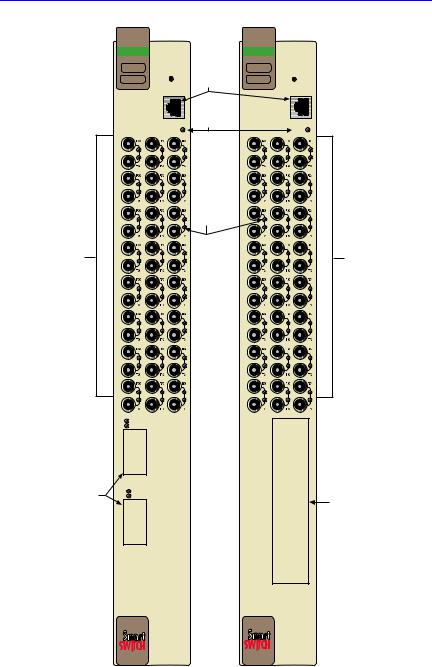
6E12X-26 and 6E13X-25 Overview
Ethernet |
Ethernet |
6E128-26 |
6E138-25 |
|
COM Ports |
COM |
COM |
|
System |
CPU |
LEDs |
CPU |
1 |
9 |
17 |
2 |
10 |
18 |
|
|
Port Status |
3 |
11 |
LEDs |
19 |
1 |
9 |
17 |
2 |
10 |
18 |
3 |
11 |
19 |
Network |
4 |
12 |
20 |
4 |
12 |
20 |
Network |
Ports 1-24 |
|
|
|
|
|
|
Ports 1-24 |
|
5 |
13 |
21 |
5 |
13 |
21 |
|
|
6 |
14 |
22 |
6 |
14 |
22 |
|
|
7 |
15 |
23 |
7 |
15 |
23 |
|
|
8 |
16 |
24 |
8 |
16 |
24 |
|
|
25 |
|
|
|
|
|
|
Fast Ethernet |
|
|
|
|
|
|
|
Interface Module |
|
|
|
|
|
|
|
Ports 25 and 26 |
|
|
|
|
|
|
HSIM Slot |
|
26 |
|
|
|
|
|
|
231101
Figure 1-1 The 6E128-26 and 6E138-25
6E128-26, 6E138-25, 6E129-26 and 6E139-25 User’s Guide |
1-3 |

Chapter 1: Introduction
1.3.1Connectivity
The 6E128-26 and 6E138-25 connect to Ethernet networks or workstations through 24 ST fiber optic ports on the front panel. These ports support multimode fiber optic cables at lengths up to 2 kilometers. The ports are IEEE 802.3 10BASE-F compliant.
The 6E129-26 and 6E139-25 connect to Ethernet networks or workstations through 24 ST fiber optic ports on the front panel. These ports support single mode fiber optic cable at lengths up to 5 kilometers. The ports are FOIRL compliant.
The 6E12X-26 modules have two front panel slots (ports 25 and 26) for optional Fast Ethernet Interface Modules to support an uplink to
100 Mbps Ethernet backbones or a high speed connection to a local server.
The 6E13X-25 modules have one front panel slot for an optional High Speed Interface Module to provide for additional connectivity to other high speed networking technologies such as ATM, WANs, Gigabit Ethernet and FDDI.
1.3.2Full Duplex Switched Ethernet
Each switched Ethernet port supports full wire-speed Ethernet communications and can be configured to operate in Full Duplex Switched Ethernet mode, which provides 20 Mbps of bandwidth.
The optional Fast Ethernet Interface Modules for the 6E12X-26 can also be configured to operate in Full Duplex Switched Ethernet mode, which provides 200 Mbps of bandwidth.
1.3.3Management
Management of the 6E12X-26 and 6E13X-25 is accomplished using Local Management tools or remote SNMP management stations. Local Management is accessible through the RS232 COM port on the front panel using a local VT100 terminal, or a remote VT100 terminal via a modem connection, and in-band via a Telnet connection. In-band remote management is possible through any SNMP compliant Network Management Software.
1-4 |
6E128-26, 6E138-25, 6E129-26 and 6E139-25 User’s Guide |

6E12X-26 and 6E13X-25 Overview
1.3.4Switching Options
The 6E12X-26 and 6E13X-25 provide 802.1D switching (bridging), 802.1Q switching or SecureFast Switching Virtual Network Services between all of the front panel interfaces including Fast Ethernet Interface Modules and High Speed Interface Modules (HSIMs).
SecureFast switching and 802.1Q switching allow for future migration to Virtual Network technologies without requiring the replacement of existing equipment.
1.3.5Standards Compatibility
The 6E12X-26 and 6E13X-25 are fully compliant with the IEEE 802.3 standard. The optional Fast Ethernet Interface Modules are fully compliant with the IEEE 802.3u standard. The 6E12X-26 and 6E13X-25 provide IEEE 802.1D Spanning Tree Algorithm (STA) support to enhance the overall reliability of the network and protect against “loop” conditions. The 6E12X-26 and 6E13X-25 support a wide variety of industry standard MIBs including RFC 1213 (MIB II), RFC 1757 (RMON), RFC 1493 (Bridge MIB) and RFC 1354 (FIB MIB). A full suite of Cabletron Systems Enterprise MIBs provide a wide array of statistical information to enhance troubleshooting.
1.3.6LANVIEW Diagnostic LEDs
LANVIEW diagnostic LEDs serve as an important troubleshooting aid by providing an easy way to observe the status of individual ports and overall network operations. Chapter 4 provides details about the 6E12X-26 and 6E13X-25 LANVIEW LEDs.
1.3.7Year 2000 Compliant
The 6E12X-26 and 6E13X-25 have an internal clock that can maintain the current time and date beyond the year 1999.
6E128-26, 6E138-25, 6E129-26 and 6E139-25 User’s Guide |
1-5 |

Chapter 1: Introduction
1.3.8Runtime IP Address Discovery
This feature enables the modules to automatically accept an IP address from a BootP server on the network into NVRAM without requiring a user to enter an IP address through Local Management.
When the modules are connected to the network and powered up, Runtime IP Address Discovery (RAD) checks the modules for an IP address. If one has not yet been assigned (module and 6C105 chassis IP address set to 0.0.0.0), RAD checks to see if any of the module interfaces have a link. If so, RAD sends out Reverse Address Resolution Protocol (RARP) and BootP requests to obtain an IP address from a BootP or RARP server on the network.
The RAD requests start out at an interval of 1 second. The interval then doubles after every transmission until an interval of 300 seconds is reached. At this point, the interval remains at 300 seconds. The RAD requests continue until an IP address is received from a BootP or RARP server, or an IP address is entered using Local Management.
1.4LOCAL MANAGEMENT FEATURES
Local Management provides the tools that allow management of the 6E12X-26 and 6E13X-25, the Fast Ethernet Interface Modules, all HSIMs, and the 6C105 chassis. Local Management for the 6E12X-26 and 6E13X-25 provides the features detailed in Sections 1.4.1 through 1.4.6.
1.4.1Distributed Chassis Management
From a management perspective, the 6C105 SmartSwitch 6000 chassis can be viewed as a single entity with a single IP address. Its management functions are distributed to all modules. This means a single module in the chassis, such as the 6E12X-26 and 6E13X-25, can be used to manage the entire chassis, and any other attached module through Local Management, SNMP, or Telnet applications.
1-6 |
6E128-26, 6E138-25, 6E129-26 and 6E139-25 User’s Guide |

Local Management Features
1.4.2Remote Monitoring (RMON)
The 6E12X-26 and 6E13X-25 supports all Ethernet RMON groups, which include Statistics, Alarms, Events and History. These groups are enabled on all ports by default.
Cabletron Systems RMON Actions is a vendor specific extension of RMON and provides the ability to set an “Action” on any SNMP MIB variable. The Action can be triggered by any RMON Event and/or Alarm. An example of an Action would be to turn off a MIB-2 interface if a broadcast threshold is crossed.
1.4.3Broadcast Suppression
Broadcast Suppression allows a user to set a desired limit of receive broadcast frames per port/per second to be forwarded out the other ports on the module up to the set limit. Any broadcast frames above this specified limit are dropped. In the event that broadcast frames are being suppressed, multicast and unicast frames continue to be switched.
1.4.4Port Redirect Function
The port redirect function, also referred to as “Port Mirroring,” is a troubleshooting tool used to map traffic from a single source port or multiple source ports to a destination port(s) within the chassis. This feature functions at the bit level, which allows all packets, including those with errors, to be copied and sent to an analyzer or RMON probe. The analyzer or RMON probe will see the data as if it is directly connected to the LAN segment of the source port(s).
6E128-26, 6E138-25, 6E129-26 and 6E139-25 User’s Guide |
1-7 |

Chapter 1: Introduction
1.4.5SmartTrunk
SmartTrunk, also referred to as SmartTrunking, is Cabletron Systems’ terminology for load balancing or load sharing. SmartTrunk technology provides an easy-to-implement mechanism to group, or aggregate, multiple links of any technology together to scale the backbone bandwidth beyond the limitations of a single link. All links are user-configurable so administrators can scale the backbone bandwidth by adding SmartTrunk links. The SmartTrunk benefits are as follows:
•All purchased bandwidth is used.
•Distributed, resilient links increase reliability and performance.
•Multiple technologies are supported within a single trunk for maximum flexibility.
For more information about SmartTrunk, refer to the Cabletron Systems
SmartTrunk User’s Guide.
1.4.6Additional Local Management Functions
Local Management also allows the following tasks to be performed:
•Manage any module installed in the 6C105 via a single terminal connection.
•Assign an IP address and subnet mask to the 6E12X-26 and 6E13X-25 modules and 6C105 chassis.
•Select a default gateway.
•Control local and remote access.
•Designate workstations to receive SNMP traps from the 6E12X-26 and 6E13X-25 modules and 6C105 chassis.
•Configure module specific SNMP MIB objects including the IETF Bridge MIB objects.
Chapter 5 provides detailed information about Local Management of the 6E12X-26 and 6E13X-25, the optional Fast Ethernet Interface Modules and the 6C105 chassis. The associated High Speed Interface Module user’s guide provides detailed information about Local Management of the applicable HSIM.
1-8 |
6E128-26, 6E138-25, 6E129-26 and 6E139-25 User’s Guide |

Optional Features
1.5OPTIONAL FEATURES
Options for the 6E12X-26 and 6E13X-25 are Fast Ethernet Interface Modules and High Speed Interface Modules, which add remote uplink capability.
Cabletron Systems provides Fast Ethernet Interface Modules for the 6E12X-26 to support uplinks to 100 Mbps Ethernet backbones or high speed connections to local servers. The Fast Ethernet Interface Modules are listed in Table 1-1.
|
Table 1-1 Fast Ethernet Interface Modules |
||
|
|
|
|
P/N |
Description |
Application |
|
|
|
|
|
|
|
|
|
|
Uses RJ45 |
Supports Category 5 Unshielded Twisted Pair |
|
FE-100TX |
(UTP) cabling with an impedance between 85 |
||
connector |
|||
|
and 111 ohms. |
||
|
|
||
|
|
|
|
FE-100FX |
Uses SC |
Supports multimode fiber optic cabling. |
|
connector |
|||
|
|
||
|
|
|
|
FE-100F3 |
Uses SC |
Supports single mode fiber optic cabling. |
|
connector |
|||
|
|
||
|
|
|
|
Cabletron Systems provides High Speed Interface Modules for the 6E13X-25 to provide for additional connectivity to other high speed networking technologies such as ATM, WANs, Gigabit Ethernet and FDDI. The HSIMs available for the 6E13X-25 are listed in the Release Notes.
6E128-26, 6E138-25, 6E129-26 and 6E139-25 User’s Guide |
1-9 |

Chapter 1: Introduction
1.6DOCUMENT CONVENTIONS
The following conventions are used throughout this document:
NOTE |
Note symbol. Calls the reader’s attention to any item of |
information that may be of special importance. |
Tip symbol. Conveys helpful hints concerning procedures or TIP actions.
Caution symbol. Contains information essential to avoid
!damage to the equipment.
CAUTION
Electrical Hazard Warning symbol. Warns against an action that could result in personal injury or death due to an electrical hazard.
1-10 6E128-26, 6E138-25, 6E129-26 and 6E139-25 User’s Guide

Getting Help
1.7GETTING HELP
For additional support related to this device or document, contact the Cabletron Systems Global Call Center:
World Wide Web |
http://www.cabletron.com/ |
|
For technical support, select Service and Support |
||
|
||
|
|
|
Phone |
(603) 332-9400 |
|
|
|
|
Internet mail |
support@ctron.com |
|
|
|
|
FTP |
ftp.cabletron.com |
|
Login |
anonymous |
|
Password |
your email address |
|
|
|
To send comments or suggestions concerning this document, contact the Cabletron Systems Technical Writing Department via the following
email address: TechWriting@ctron.com
Make sure to include the document Part Number in the email message.
Before calling the Cabletron Systems Global Call Center, have the following information ready:
•Your Cabletron Systems service contract number
•A description of the failure
•A description of any action(s) already taken to resolve the problem (e.g., changing mode switches, rebooting the unit, etc.)
•The serial and revision numbers of all involved Cabletron Systems products in the network
•A description of your network environment (layout, cable type, etc.)
•Network load and frame size at the time of trouble (if known)
•The device history (i.e., have you returned the device before, is this a recurring problem, etc.)
•Any previous Return Material Authorization (RMA) numbers
6E128-26, 6E138-25, 6E129-26 and 6E139-25 User’s Guide |
1-11 |

Chapter 1: Introduction
1.8RELATED MANUALS
The following manuals may help to set up, control, and manage the 6E12X-26 and 6E13X-25:
Cabletron Systems HSIM-A6DP User’s Guide
Cabletron Systems HSIM-F6 User’s Guide
Cabletron Systems HSIM-FE6 User’s Guide
Cabletron Systems HSIM-W6 User’s Guide
Cabletron Systems HSIM-W84 User’s Guide
Cabletron Systems HSIM-W87 User’s Guide
Cabletron Systems HSIM-G01/G09 User’s Guide
Cabletron Systems Ethernet Technology Guide
Cabletron Systems Cabling Guide
Cabletron Systems Port Based VLAN User’s Guide
Cabletron Systems SmartTrunk User’s Guide
These manuals can be obtained from the World Wide Web in Adobe Acrobat Portable Document Format (PDF) at the following site:
http://www.cabletron.com/
NOTE |
All documentation for the Cabletron Systems SecureFast VLAN |
Manager software is contained on the VLAN Manager |
|
|
CD-ROM. |
1-12 6E128-26, 6E138-25, 6E129-26 and 6E139-25 User’s Guide

CHAPTER 2
NETWORK REQUIREMENTS
Before installing the 6E12X-26 and 6E13X-25 or Fast Ethernet Interface Modules (FE-100TX, FE-100FX, or FE-100F3), review the requirements and specifications referred to in this chapter concerning the following:
•SmartTrunk (Section 2.1)
•10BASE-F Fiber Optic Network (Section 2.2)
•FOIRL Single Mode Fiber Optic Network (Section 2.3)
•100BASE-TX Twisted Pair Network (Section 2.4)
•100BASE-FX Fiber Optic Network (Section 2.5)
The network installation must meet the guidelines to ensure satisfactory performance of this equipment. Failure to follow the guidelines may produce poor network performance.
NOTE |
The Cabletron Systems Cabling Guide and SmartTrunk User’s
Guide, referred to in the following sections, can be found on the Cabletron Systems World Wide Web
site: http://www.cabletron.com/
2.1SmartTrunk
To connect the 6E12X-26 and 6E13X-25 to a network so it can take advantage of the SmartTrunk feature, there are certain rules concerning port connections and configurations that must be followed for proper operation. Refer to the Cabletron Systems SmartTrunk User’s Guide for additional information.
6E128-26, 6E138-25, 6E129-26 and 6E139-25 User’s Guide |
2-1 |

Chapter 2: Network Requirements
2.210BASE-F NETWORK
When connecting a 10BASE-F segment to any of the 6E128-26 and 6E138-25 ports (Interfaces 1 through 24), ensure that the network meets the Ethernet network requirements of the IEEE 802.3 standard for 10BASE-F. Refer to the Cabletron Systems Cabling Guide for details.
2.3FOIRL NETWORK
When connecting a FOIRL single mode segment to any of the 6E129-26 and 6E139-25 ports (Interfaces 1 through 24), ensure that the network meets the Ethernet network requirements of the IEEE 802.3 standard for FOIRL. Refer to the Cabletron Systems Cabling Guide for details.
2.4100BASE-TX NETWORK
The 6E12X-26, with an FE-100TX installed in ports 25 and 26, provides an RJ45 connection that supports Category 5 UTP cabling. The device at the other end of the twisted pair segment must meet IEEE 802.3u 100BASE-TX Fast Ethernet network requirements for the devices to operate at 100 Mbps. Refer to the Cabletron Systems Cabling Guide for details.
NOTE |
The 6E12X-26 with an FE-100TX installed is capable of |
operating at either 10 or 100 Mbps. The FE-100TX can |
|
|
automatically sense the speed of the other device and adjust |
|
its speed accordingly. |
2.5100BASE-FX FIBER OPTIC NETWORK
Ports 25 and 26 of the 6E12X-26 support the Cabletron Systems FE-100FX and FE-100F3 fiber optic interface modules. The device at the other end of the fiber optic segment must meet the 100BASE-FX Fast Ethernet network requirements to operate at 100 Mbps. Refer to the Cabletron Systems Cabling Guide for details.
Multimode Mode Fiber Optic Cable Length
The maximum multimode fiber optic cable length of a 100BASE-FX segment is covered in the Cabletron Systems Cabling Guide.
Single Mode Fiber Cable Lengths
The maximum single mode fiber optic length of a 100BASE-FX segment may be no more than 5 km between Data Terminal Equipment (DTE to DTE) in half duplex mode or 20 km (DTE to DTE) in full duplex mode.
2-2 |
6E128-26, 6E138-25, 6E129-26 and 6E139-25 User’s Guide |

CHAPTER 3
INSTALLATION
Only qualified personnel should install the 6E12X-26 and 6E13X-25.
This chapter covers the following items:
•Required tools
•Unpacking the 6E12X-26 and 6E13X-25
•Power Supply requirements specific to the 6E12X-26 and 6E13X-25
•Installing the 6E12X-26 and 6E13X-25 into the 6C105 chassis
•Connecting to the network
3.1REQUIRED TOOLS
A Phillips screwdriver is required to install the optional Fast Ethernet Interface Modules into the 6E12X-26.
3.2UNPACKING THE 6E12X-26 AND 6E13X-25
1.Open the box and remove the packing material protecting the module.
2.Verify the contents of the carton as listed in Table 3-1.
Table 3-1 Contents of Shipping Carton
Item |
Quantity |
|
|
|
|
6E138-25, 6E128-26 |
|
6E139-25 or |
1 |
6E129-26 |
|
|
|
Manual Accessory Kit |
1 |
|
|
NOTE |
Before proceeding with the installation, visually inspect the |
module for damage. If the module appears to de damaged |
|
|
contact Cabletron Systems Global Call Center. Refer to |
|
Section 1.7 for details. |
6E128-26, 6E138-25, 6E129-26 and 6E139-25 User’s Guide |
3-1 |
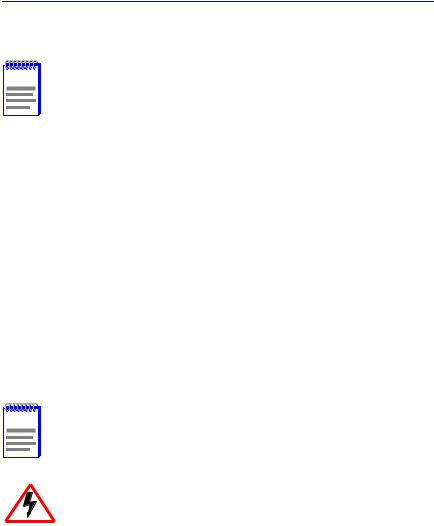
Chapter 3: Installation
3.36E12X-26 AND 6E13X-25 OPTIONS
NOTE |
Install any optional equipment before proceeding to |
Section 3.5. |
If the 6E12X-26 is to be installed with an optional Fast Ethernet Interface Module, refer to Appendix C for installation instructions. The installation instructions for the HSIMs available for the 6E13X-25 are located in the associated user’s guide.
3.4POWER SUPPLY REQUIREMENTS
Before installing the 6E12X-26 and 6E13X-25 into the 6C105 chassis, ensure the following power supply requirements are met:
•If the 6C105 chassis is using 6C205-1 power supplies, there may be no more than three 6E12X-26 and 6E13X-25s installed in the chassis for the power supplies to remain in a redundant state. If more than three 6E12X-26 and 6E13X-25s are installed, the chassis will operate normally, with the exception of supporting redundant power supplies.
NOTE |
The name of the power supply (e.g. 6C205-1) may be found on |
the front panel of the power supply. |
If the 6C105 chassis has only one 6C205-1 power supply installed, DO NOT install more than three 6E12X-26 and 6E13X-25s into the chassis.
•If the 6C105 chassis is using 6C205-2 or 6C205-3 power supplies, the chassis can support any type of module configuration.
3-2 |
6E128-26, 6E138-25, 6E129-26 and 6E139-25 User’s Guide |

Installing the 6E12X-26 and 6E13X-25 Into the 6C105 Chassis
3.5INSTALLING THE 6E12X-26 AND 6E13X-25 INTO THE 6C105 CHASSIS
Failure to observe static safety precautions could cause
!damage to the 6E12X-26 and 6E13X-25. Follow static safety
CAUTION |
handling rules and properly wear the antistatic wrist strap |
|
|
|
provided with the 6C105 chassis. |
Do not cut the non-conductive bag to remove the module. Damage could result from sharp objects contacting the board or components.
The 6E12X-26 and 6E13X-25 can be installed in any of the 5 slots that are available. To install a module, proceed as follows:
1.Remove the blank panel covering the slot in which the module will be installed. All other slots must remain covered to ensure proper airflow and cooling. (Save the blank plate in the event you need to remove the module.)
2.Carefully remove the module from the shipping box. (Save the box and packing materials in the event the module must be reshipped.)
3.Locate the antistatic wrist strap shipped with the 6C105 chassis. Attach the strap to your wrist and plug the cable from the antistatic wrist strap into the ESD grounding receptacle at the upper right corner of the 6C105.
4.Remove the module from the plastic bag. (Save the bag in the event the module must be reshipped.) Observe all precautions to prevent damage from Electrostatic Discharge (ESD).
5.Examine the module for damage. If any damage exists, DO NOT install the module. Immediately contact the Cabletron Systems Global Call Center.
To prevent damaging the backplane connectors in the following
!step, take care that the module slides in straight and properly
CAUTION |
engages the backplane connectors. |
|
NOTE |
In the following step, ensure that the top plastic locking tab |
lines up with the desired slot number located on the front panel |
|
|
of the chassis. Refer to Figure 3-1. |
6E128-26, 6E138-25, 6E129-26 and 6E139-25 User’s Guide |
3-3 |
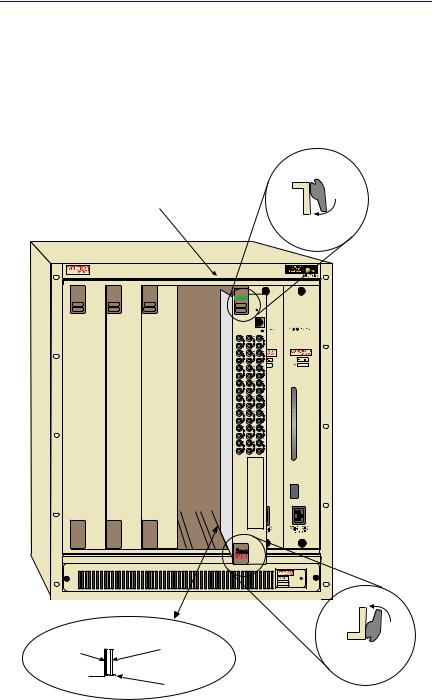
Chapter 3: Installation
6.Locate the slot guides that line up with the number of the slot in which the module will be installed. Install the module in the chassis by aligning the module circuit card between the upper and lower metal rail guides of the desired slot, sliding it into the chassis, and locking down the top and bottom plastic locking tabs, as shown in Figure 3-1. Take care that the module slides in straight and properly engages the backplane connectors.
Slot Number
Plastic Locking Tab
1 |
2 |
3 |
4 |
5 |
|
PS1 |
PS2 |
|
|
|
|
Ethernet |
|
|
|
|
|
|
|
6E138-25 |
|
|
|
|
|
|
|
|
COM |
|
|
|
|
|
|
|
|
CPU |
|
|
|
|
|
1 |
9 |
17 |
|
|
|
|
|
2 |
10 |
18 |
|
|
|
|
|
3 |
11 |
19 |
|
|
|
|
|
4 |
12 |
20 |
|
|
|
|
|
5 |
13 |
21 |
|
|
|
|
|
6 |
14 |
22 |
|
|
|
|
|
7 |
15 |
23 |
|
|
|
|
|
8 |
16 |
24 |
|
Metal Back-Panel |
Circuit Card |
Plastic Locking Tab |
|
||
|
|
|
|
Card Guides |
231102 |
Figure 3-1 Installing an Interface Module
3-4 |
6E128-26, 6E138-25, 6E129-26 and 6E139-25 User’s Guide |
